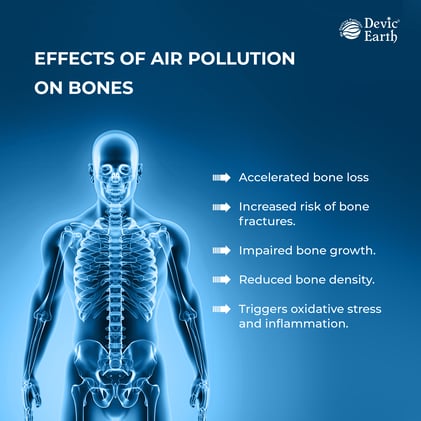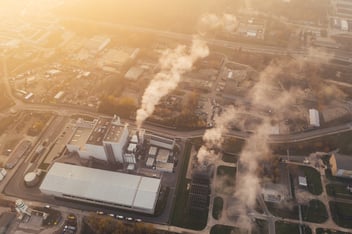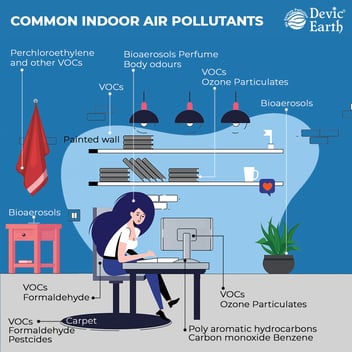Air Pollution and Bone Loss: Connecting the Dots
You may not be aware, but your respiratory system isn't the only one that air pollution is harming. According to recent research, air pollution may be to blame for human bones becoming more brittle and raising the risk of osteoporosis.
According to a study from Duke University in North Carolina, prolonged exposure to air pollution can hasten bone loss and increase the risk of bone fractures. People who reside in areas with higher levels of fine particulate matter (PM2.5) have a higher incidence of bone fractures than those who reside in less polluted areas, according to the study, which examined data from 9.2 million people in the US.
The problem of air pollution is particularly severe in India, with cities like Delhi and Mumbai frequently recording some of the highest levels in the world of air pollution.
What are these pollutants and How do they affect our bones?

There are several pollutants that may contribute to the development of osteoporosis, including:
- Particulate matter (PM): PM is a mixture of tiny particles and liquid droplets that can be inhaled and can penetrate deep into the lungs. Sources of PM include industrial emissions, traffic, and wildfires. PM exposure can lead to increased inflammation and oxidative stress in the body, which can contribute to bone loss and osteoporosis.
- Nitrogen dioxide (NO2): NO2 is a gas that is primarily produced by motor vehicles, power plants, and industrial activities. NO2 exposure has been linked to reduced bone density and increased risk of fractures.
- Sulphur dioxide (SO2): SO2 is a gas that is produced by burning fossil fuels, such as coal and oil. SO2 exposure can contribute to bone loss and may increase the risk of fractures.
- Ozone (O3): Ozone is a gas that is formed when certain pollutants, such as nitrogen oxides and volatile organic compounds, react in the presence of sunlight. Ozone exposure can lead to oxidative stress and inflammation, which can contribute to bone loss.
What can we do to protect ourselves?
Preventing or reducing the risk of osteoporosis due to air pollution exposure may involve several measures, including:
- Reducing exposure to air pollution: It is essential to limit exposure to air pollution as much as possible. This may involve avoiding outdoor activities during times when pollution levels are high, using air purifiers in the home or workplace, and reducing exposure to indoor pollutants such as tobacco smoke and cooking fumes.
- Regular exercise: Regular physical activity, particularly weight-bearing exercises, can help maintain bone health and prevent bone loss.
- Adequate calcium and vitamin D intake: Adequate calcium and vitamin D intake are essential for building and maintaining strong bones. Foods such as milk, cheese, and leafy green vegetables are good sources of calcium, while exposure to sunlight is an excellent source of vitamin D.
- Avoid smoking and excessive alcohol consumption: Smoking and excessive alcohol consumption can have negative effects on bone health and increase the risk of osteoporosis.
- Medical treatment: If diagnosed with osteoporosis, medical treatment may be necessary to prevent further bone loss and reduce the risk of fractures. Treatment options may include medications that slow bone loss, calcium and vitamin D supplements, and hormone replacement therapy.
Conclusion:
In India, the issue of air pollution is of great concern, with cities like Delhi and Mumbai often experiencing some of the highest levels in the world. The latest research suggesting that air pollution can also harm our bones and increase the risk of osteoporosis only adds to the urgency of tackling this issue.
As individuals, we can take action by reducing our exposure to air pollution, engaging in regular physical activity, consuming a diet rich in calcium and vitamin D, and avoiding smoking and excessive alcohol consumption. However, this issue requires a collective effort from governments, organizations, and individuals to bring about real change.
How much longer can we afford to ignore the urgent need to take action against air pollution and its growing detrimental effects on human health and environment?
References:
https://www.sciencealert.com/air-pollution-is-making-human-bones-more-brittle-study-suggests
https://www.hindustantimes.com/lifestyle/health/air-pollution-speeds-bone-loss-from-osteoporosis-research-101677045881426.html
https://www.ncbi.nlm.nih.gov/pmc/articles/PMC8238075/

.svg)
.webp?width=1080&height=1080&name=Free%20Case%20Study%20Steel%20Plant%20(1).webp)







Post Comments